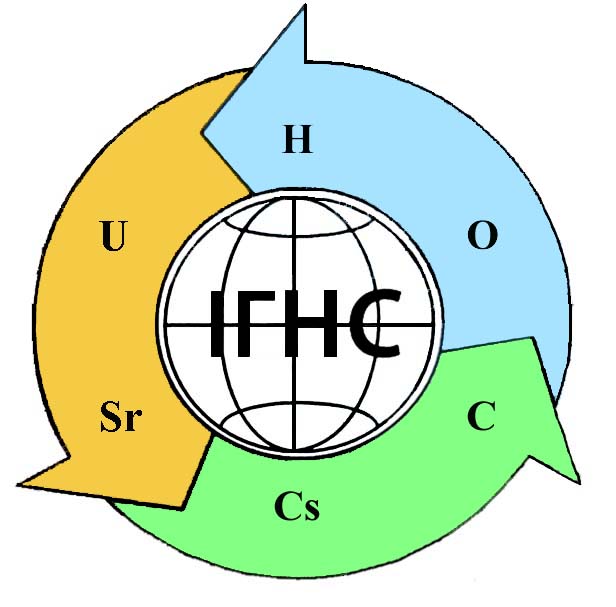FRACTIONATION OF HEAVY HYDROGEN ISOTOPES IN DYNAMICAL SYSTEMS
DOI:
https://doi.org/10.15407/geotech2019.30.026Keywords:
tritium, deuterium, heavy water, fractionation, adsorbent, montmorillonite, sepiolite, palygorskite.Abstract
The possibility of using mineral adsorbents for cleaning the moderator of heavy water reactors from tritium is determined. Three dynamic systems have been created where montmorilonite, sepiolite and palygorskite clays and zeolite (systems M-Z, S-Z and P-Z) are used as composite membranes. At the first stage, deuterium-tritium water (DTO) was filtered through mineral membranes, and at the second stage, the same membranes were washed with protium water (Н2О). In the process of such a two-stage filtration, the effect of separation of tritium and deuterium in the filtrate was first established. At the first stage of the experiment, the content of deuterium and tritium in the DTO filtrate in the system with an M-Z membrane was equally reduced and at the end of the filtration was slightly more than 50% of the initial concentrations. The separation coefficient of heavy hydrogen isotopes in this system did not exceed KT = 0.99. When DTO was filtered through the C-Z membrane, the fraction of tritium in the filtrate at the end of filtration decreased by 10% relative to the initial concentration less than the fraction of deuterium and the hydrogen isotope separation coefficient was KT = 1.15. In the P-C system, the residual fraction of deuterium DTO filtrate was 3% higher than the residual fraction of tritium and the hydrogen isotope separation coefficient was determined at the level of KT = 0.96. Another process is observed when filtering protium water (Н2О) through clay-zeolite adsorbents after their interaction with a DTO solution. In all the studied mineral adsorbents, the manifestations of fractionation of heavy hydrogen isotopes with coefficients KD = 13.2, 3.2 and 3.6, respectively, were established for montmorillonite-zeolite, sepiolite-zeolite and palygorskite-zeolite composites with a predominant deuterium content in the filtrate, which indicates on the possibility of using clay-zeolite mineral adsorbents for the purification of heavy water from tritium..
References
Audi G., Bersillon O., Blachot J., Wapstra A.H. The NUBASE evaluation of nuclear and decay properties. Nuclear Physics. 2003. A 729. Р. 3–128.
Audi G., Wapstra A.H., Thibault C. The AME2012 atomic mass evaluation (II). Tables, graphs, and references // Chinese Physics C. 2012. V. 36, N 12. Р. 1603-2014
Butler, H.L. Tritium Hazards in Heavy-Water-Moderated Reactors, Nucl. Safety, 1963. 4, (3). P. 77-82.
Jackson, R.F.. Experience of Operation and Use of the UK High-Flux Research Reactors.//Proceedings of the Third International Conference of the Peaceful Uses of Atomic Energy, Geneva, United Nations, New York. 1964. P.168-175.
Matic-Vukmirovic, Z. Determination of the tritium buildup in a heavy-watermoderated reactor. Proceedings of the Third International Conference on the Peaceful Uses of Atomic Energy. Geneva, United Nations, New York. 1965. 3. P.407-413.
Patterson, C.M. Radiation Protection Considerations in a Heavy-Water-Moderated Reactor. Proceedings of the Second United Nations International Conference on the Peaceful Uses of Atomic Energy, Geneva, United Nations,New York. 1958, Vol. 23, P.295-301.,
Pushkarev V., Rudenko I., Zubko O., Dolin V. (Jr.) Nitrogen and humic acid activation of alumosilicatesfor improving the adsorption of tritium from water solutions , Visnyk of Taras Shevchenko National University of Kyiv: Geology. (2019). v. 1(84). pp. 16-20. http://doi.org/10.17721/1728-2713.84.02
Бердоносов С.С. Изотопные эффекты / Химическая энциклопедия: в 5 томах. Т. 2. М.: Советская энциклопедия, 1990. – С. 383.
Мосин О.В., Складнев Д.А., Швец В.И. Методы получения белков и аминокислот, меченных стабильными изотопами 2 Н, 13С и 15N . Биотехнология, 1996. № 3, С. 12–32,
Пушкарев А. В., Руденко И. М., Скрипкин В. В. Адсорбция трития из водных растворов термически обработаными глинистыми минералами. Вісник Київського національного університету, (Геологія). Київ, 2015, 71. С. 43 – 48.
Пушкарьов О. В., Руденко І. М., Долін В. В. (мол.), Сепіоліт-цеолітові композити як потенційні водопроникні реакційні бар’єри/, Приймаченко В. М.// Збірник наукових праць Інституту геохімії навколишнього середовища. Київ, 2014. Вип.23. С.75 -84.
Пушкарьов О.В., Приймаченко В.М. Взаємодія тритієвої води з глинистими мінералами. Збірник наукових праць Інституту геохімії навколишнього середовища. Київ, 2010. Вип.18. C.149 -158
Пушкрьов О.В., Приймаченко В.М. Золкін І.О. Властивості бентоніто-цеолітових композитів щодо вилучення тритію з тритієвої води. Збірник наукових праць Інституту геохімії навколишнього середовища. Київ, 2012. Вип.20. С. 98 -107.
Синяк Ю.Е., Григорьев А.И., Гайдадымов В.В., Медникова Е.И., Лебедева З.Н., Гуськова Е.И. Метод получения бездейте- риевой воды и исследование ее влияния на физиологический статус, Космическая биология и авиакосмическая медицина / Материалы XI конференции. 1998, № 2, с. 201
Скульский Н.А., Демихов Ю.Н., Лысенко О.Б., Соботович Э.В. Фракционирование триады изотопов водорода: теория, эксперимент, перспективы // Зб. наук. праць Ін-ту геохімії навколишнього середовища НАН та МНС України. 2011. Вип. 19. С. 77–86. 16. Тритієвий індикатор ефективності термомодифікації адсорбційних властивостей кліноптилоліту. Руденко І.М., Пушкарьов О.В., Долін В.Віт., Зубко О.В., Гречановська О.Є. Мінералогічний журнал. Київ, 2017. Т.39, 2. C.64 -74.









